Mpal Virus File
Mpal is a DJVU family of ransomware-type infections1. This infection encrypts important personal files (video, photos, documents). The infected files can be tracked by specific “.mpal” extension. So, you can’t use them at all.
In this guide I will try to help you remove Mpal virus for free. Also, I will assist you in decoding your encrypted files.
What is “Mpal”?
Mpal can be correctly identify as a ransomware-type infection.
Ransomware is a kind of virus that encrypted your documents and then forces you to pay to restore them. Note that DJVU (aka STOP) ransomware family was first revealed and analyzed by virus analyst Michael Gillespie2.Mpal is basically similar to other ransomware like: Lalo, Qewe, Lezp. It encrypted all popular file types. Hence, you cannot work with the your documents . Mpal adds its particular “.mpal” extension into all files. For instance, the file “video.avi”, will be amended into “video.avi.mpal”. As soon as the encryption is accomplished, Mpal generates a specific text file “_readme.txt” and drop it into all folders that contain the modified files.
Here is a info for the Mpal :
| Ransomware family3 | DJVU/STOP4 ransomware |
| Extension | .mpal |
| Ransomware note | _readme.txt |
| Ransom | From $490 to $980 (in Bitcoins) |
| Contact | helpmanager@mail.ch, helpdatarestore@firemail.cc |
| Detection | Backdoor.MSIL.Broide, MSIL/Agent.CKL, Locky.8 |
| Symptoms | Most of your files (photos, videos, documents) have a .mpal extension and you can’t open it |
| Fix Tool | See If Your System Has Been Affected by .mpal file virus |
This text asking payment is for restore files via decryption key:
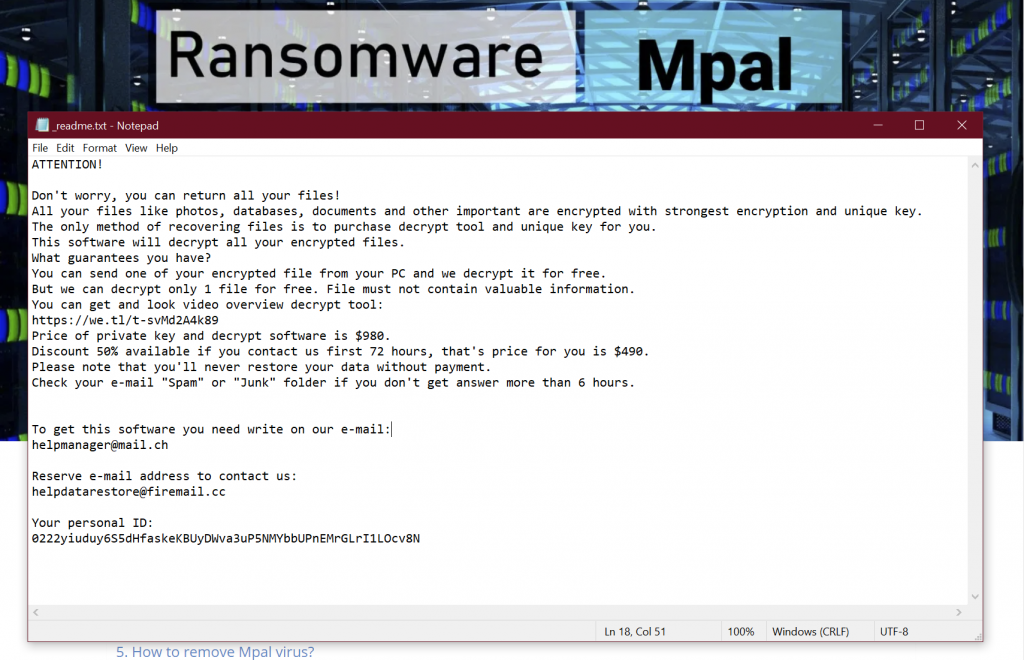
The scary alert demanding from users to pay the ransom to decrypt the encoded data contains these frustrating warnings
The cryptography algorithm used by Mpal is AES-256. So, if your files got encrypted with a specific decryption key, which is totally and there are no other copies. The sad reality is that it is impossible to recover the information without the unique key available.
In case if Mpal worked in online mode, it is impossible for you to gain access to the AES-256 key. It is stored on a distant server owned by the frauds who distribute the Mpal ransomware.
An offline key for Mpal ransomware is much easier to find and use for decryption. You can check if you have an offline key. Find SystemID folder and open PersonalID file in it. If this file contains an entity which ends on “t1” – you are lucky.
For receiving decryption key the payment should be $980. To obtain the payment details the victims are encouraged by the message to contact the frauds by email (helpmanager@mail.ch), or via Telegram.
Do not pay for Mpal!
Please, try to use the available backups, or Decrypter tool
_readme.txt file also indicates that the computer owners must get in touch with the Mpal representatives during 72 hours starting from the moment of files where encrypted. On the condition of getting in touch within 72 hours, users will be granted a 50% rebate, thus the ransom amount will be minimized down to $490). Yet, stay away from paying the ransom!
I strongly advise that you do not contact these frauds and do not pay. The one of the most real working solution to recover the lost data – just using the available backups, or use Decrypter tool.
And this advice is highly-desirable to follow. Fraudsters will do everything to force user to pay them, so their methods can be quite cruel. For example, they can menace that your files will be deleted, or that you wouldn’t find a key, and your files will stay encrypted forever.
They can also show that they really have a decryptor, which can make your files back. They’re offering you to decrypt 1-2 of your files, and they really can do this. But no one can guarantee that they will send you a decryption key after your payment. So the only solution that can surely help you is one that I am describing in this article.
And, finally, even if fraudsters fail in getting paid, they can make a profit via selling your e-mail (and e-mails of all victims who contacted them) to other croocks. They could be another ransomware distributors, or just spammers, but anyway – your e-mail will sink in spam.
The peculiarity of all such viruses apply a similar set of actions for generating the unique decryption key to recover the ciphered data.
Thus, unless the ransomware is still under the stage of development or possesses some hard-to-track flaws, manually recovering the ciphered data is a thing you can’t really perform. The only solution to prevent the loss of your valuable data is to regularly make backups of your crucial files.
Note that even if you do maintain such backups regularly, they ought to be put into a specific location without loitering, not being connected to your main workstation.
Mpal ransomware can counter-act your backups in several ways. The first one is a simple encryption of backup files. But much more often, Mpal injects it’s .exe file into backup. Hence, later, you can try to use this backup to restore your system, but would be frustrated heavily because of new ransomware attack.
One more typical Mpal ransomware action against backups is disabling/deleting the backups, which were created with Windows built-in tool. It’s hard to save such backups, so it’s much better to use any other backup creation tool.
Pay a lot of attention to your PC performance. The weak systems can be slowed down significantly by Mpal ransomware, because of specific encryption behaviour. So, if you noticed your computer lagspiking or sluggish – that could be a sign of ransomware (or another serious malware, like trojan-miner) presence.
For instance, the backup may be kept on the USB flash drive or some alternative external hard drive storage. Optionally, you may refer to the help of online (cloud) information storage.
But the external drives can be attacked, too. In spite of encryption it can copy it’s .exe file to your USB, so it become portable ransomware carrier. So, if you been attacked by Mpal ransomware – do not plug in any USB drives until you’re not in “safe mode”, which can stop encryption and ransomware spreading.
Needless to mention, when you maintain your backup data on your common device, it may be similarly ciphered as well as other data.
For this reason, locating the backup on your main PC is surely not a good idea.
How I was infected?
Mpal has a various methods to built into your system. But it doesn’t really matter what concrete method had place in your case.

Mpal ransomware attack following a successful phishing attempt.
- hidden installation along with other apps, especially the utilities that work as freeware or shareware;
- dubious link in spam emails leading to the Mpal installer
- online free hosting resources;
- using illegal peer-to-peer (P2P) resources for downloading pirated software.
There were cases when the Mpal virus was disguised as some legitimate tool, for example, in the messages demanding to initiate some unwanted software or browser updates. This is typically the way how some online frauds aim to force you into installing the Mpal ransomware manually, by actually making you directly participate in this process.
The typical situation for all ransomware is it’s distribution as a part of the pack of different malware. And Mpal ransomware is not an exclusion. According to several reports from trusted sources, the most popular type of “satellite” malware for Mpal is adware and backdoors. The second one is hard-to-track, but the first one has quite a clear syptoms – every 30-45 minutes your browser will open a separate window with a site, full of disgusting advertiserments.
Another frequently-met malware that can be met along with Mpal ransomware is a Wup Trojan. It’s a trojan-miner, that uses your PC’s hardware to mine cryptocurrencies. Of course, it consumes a lot of capacity, so even quite new and powerful machines will get a significant slowdown.
Surely, the bogus update alert will not indicate that you are going to actually inject the Mpal ransomware. This installation will be concealed under some alert mentioning that allegedly you should update Adobe Flash Player or some other dubious program whatsoever.
Of course, the cracked apps represent the damage too. Using P2P is both illegal and may result in the injection of serious malware, including the Mpal ransomware.
One of the biggest sources of contaminated software are peering networks (also known as torrent-trackers). The common practise for software that is distributed in such way are “installators”, which are called to evade the license checking process. And this “installators” can easily be contaminated with any malware, including Mpal ransomware.
To sum up, what can you do to avoid the injection of the Mpal ransomware into your device? Even though there is no 100% guarantee to prevent your PC from getting damaged, there are certain tips I want to give you to prevent the Mpal penetration. You must be cautious while installing free software today.
UPD. 21.05.2020. The new Mpal ransomware distribution wave started. A lot of users comlied us about plenty advertiserments, that forcedly redirects to the suspicious file downloading. This file contains a lot of different malware – usually adware and the trojan-stealer, but the main malware in such pack is Mpal ransomware.
Make sure you always read what the installers offer in addition to the main free program. Stay away from opening dubious email attachments. Do not open files from the unknown addressees. Of course, your current security program must be always updated.
The malware does not speak openly about itself. It will not be mentioned in the list of your available programs. However, it will be masked under some malicious process running regularly in the background, starting from the moment when you launch your PC.
The message by the Mpal ransomware states the following frustrating information:
ATTENTION! Don't worry, you can return all your files! All your files like photos, databases, documents and other important are encrypted with strongest encryption and unique key. The only method of recovering files is to purchase decrypt tool and unique key for you. This software will decrypt all your encrypted files. What guarantees you have? You can send one of your encrypted file from your PC and we decrypt it for free. But we can decrypt only 1 file for free. File must not contain valuable information. You can get and look video overview decrypt tool: https://we.tl/t-WJa63R98Ku Price of private key and decrypt software is $980. Discount 50% available if you contact us first 72 hours, that's price for you is $490. Please note that you'll never restore your data without payment. Check your e-mail "Spam" or "Junk" folder if you don't get answer more than 6 hours. To get this software you need write on our e-mail: helpdatarestore@firemail.cc Reserve e-mail address to contact us: helpmanager@mail.ch Your personal ID: XXXXXXXXXXXXXXXXXXXXXXXXXXXXXXX
The image below gives a clear vision of how the files with “.mpal” extension look like:
How to remove Mpal virus?
In addition to encode a victim’s files, the Mpal virus has also started to install the Azorult Spyware on system to steal account credentials, cryptocurrency wallets, desktop files, and more.
Reasons why I would recommend GridinSoft5
The is an excellent way to deal with recognizing and removing threats – using Gridinsoft Anti-Malware. This program will scan your PC, find and neutralize all suspicious processes6.
Download Removal Tool.
You can download GridinSoft Anti-Malware by clicking the button below:
Run the setup file.
When setup file has finished downloading, double-click on the setup-antimalware-fix.exe file to install GridinSoft Anti-Malware on your system.

An User Account Control asking you about to allow GridinSoft Anti-Malware to make changes to your device. So, you should click “Yes” to continue with the installation.

Press “Install” button.

Once installed, Anti-Malware will automatically run.

Wait for the Anti-Malware scan to complete.
GridinSoft Anti-Malware will automatically start scanning your PC for Mpal infections and other malicious programs. This process can take a 20-30 minutes, so I suggest you periodically check on the status of the scan process.

Click on “Clean Now”.
When the scan has completed, you will see the list of infections that GridinSoft Anti-Malware has detected. To remove them click on the “Clean Now” button in right corner.

How to decrypt .mpal files?
Restore solution for big “.mpal files“
Try removing .mpal extension on a few BIG files and opening them. Either the Mpal ransomware read and did not encrypt the file, or it bugged and did not add the filemarker. If your files are very large (2GB+), the latter is most likely. Please, let me know in comments if that will work for you.
The newest extensions released around the end of August 2019 after the criminals made changes. This includes Mpal, Qewe, Lezp, etc.
As a result of the changes made by the criminals, STOPDecrypter is no longer supported. Tt has been removed and replaced with the Emsisoft Decryptor for STOP Djvu Ransomware developed by Emsisoft and Michael Gillespie.
You can download free decryption tool here: Decryptor for STOP Djvu.
Download and run decryption tool.
Start downloading the decryption tool.
Make sure to launch the decryption utility as an administrator. You need to agree with the license terms that will come up. For this purpose, click on the “Yes” button:
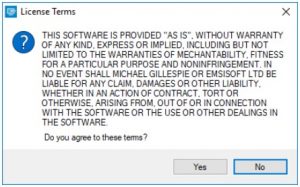
As soon as you accept the license terms, the main decryptor user interface comes up:
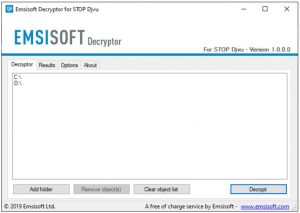
Select folders for decryption.
Based on the default settings, the decryptor will automatically populate the available locations in order to decrypt the currently available drives (the connected ones), including the network drives. Extra (optional) locations can be selected with the help of the “Add” button.
Decryptors normally suggest several options considering the specific malware family. The current possible options are presented in the Options tab and can be activated or deactivated there. You may locate a detailed list of the currently active Options below.
Click on the “Decrypt” button.
As soon as yo add all the desired locations for decryption into the list, click on the “Decrypt” button in order to initiate the decryption procedure.
Note that the main screen may turn you to a status view, letting you know of the active process and the decryption statistics of your data:
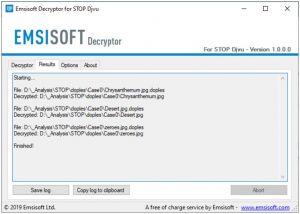
The decryptor will notify you as soon as the decryption procedure is completed. If you need the report for your personal papers, you can save it by choosing the “Save log” button. Note that it is also possible to copy it directly to your clipboard and to paste it into emails or forum messages if you need to do so.
Frequently Asked Questions
How can I open “.mpal” files?
mpal files contain important information. How can I decrypt them urgently?
If not, then you can try to restore them through the system function – Restore Point.
All other methods will require patience.
You have advised using GridinSoft Anti-Malware to remove Mpal. Does this mean that the program will delete my encrypted files?
You need GridinSoft Anti-Malware to remove active system infections. The virus that encrypted your files is most likely still active and periodically,
runs a test for the ability to encrypt even more files. In addition, these viruses install keyloggers and backdoors for further malicious actions
(for example theft of passwords, credit cards) often.
Decrytor did not decrypt all my files, or not all of them were decrypted. What should I do?
We will keep you posted on when new Mpal keys or new decryption programs appear.
What can I do right now?
- Files you downloaded from the Internet that were encrypted and you can download again to get the original.
- Pictures that you shared with family and friends that they can just send back to you.
- Photos that you uploaded on social media or cloud services like Carbonite, OneDrive, iDrive, Google Drive, etc)
- Attachments in emails you sent or received and saved.
- Files on an older computer, flash drive, external drive, camera memory card, or iPhone where you transferred data to the infected computer.
If your computer is infected with ransomware, I recommend that you contact the following government fraud and scam sites to report this attack:
- In the United States: On Guard Online;
- In Canada: Canadian Anti-Fraud Centre;
- In the United Kingdom: Action Fraud;
- In Australia: SCAMwatch;
- In New Zealand: Consumer Affairs Scams;
- In France: Agence nationale de la sécurité des systèmes d’information;
- In Germany: Bundesamt für Sicherheit in der Informationstechnik;
- In Ireland: An Garda Síochána;
Video Guide
It’s my favorite video tutorial: How to use GridinSoft Anti-Malware and Emsisoft Decryptor for fix ransomware infections.
If the guide doesn’t help you to remove Mpal virus, please download the GridinSoft Anti-Malware that I recommended. Also, you can always ask me in the comments for getting help. Good luck!
I need your help to share this article.
It is your turn to help other people. I have written this guide to help people like you. You can use the buttons below to share this on your favorite social media Facebook, Twitter, or Reddit.
Brendan SmithHow to use GridinSoft Anti-Malware and Emsisoft Decryptor for fix MPAL ransomware infections.
User Review
( votes)References
- Ransomware-type infection: https://en.wikipedia.org/wiki/Ransomware
- Twitter: https://twitter.com/demonslay335
- My files are encrypted by ransomware, what should I do now?
- About DJVU (STOP) Ransomware.
- GridinSoft Anti-Malware Review from TrustCoyote site: https://trustcoyote.com
- More information about GridinSoft products: https://gridinsoft.com/comparison

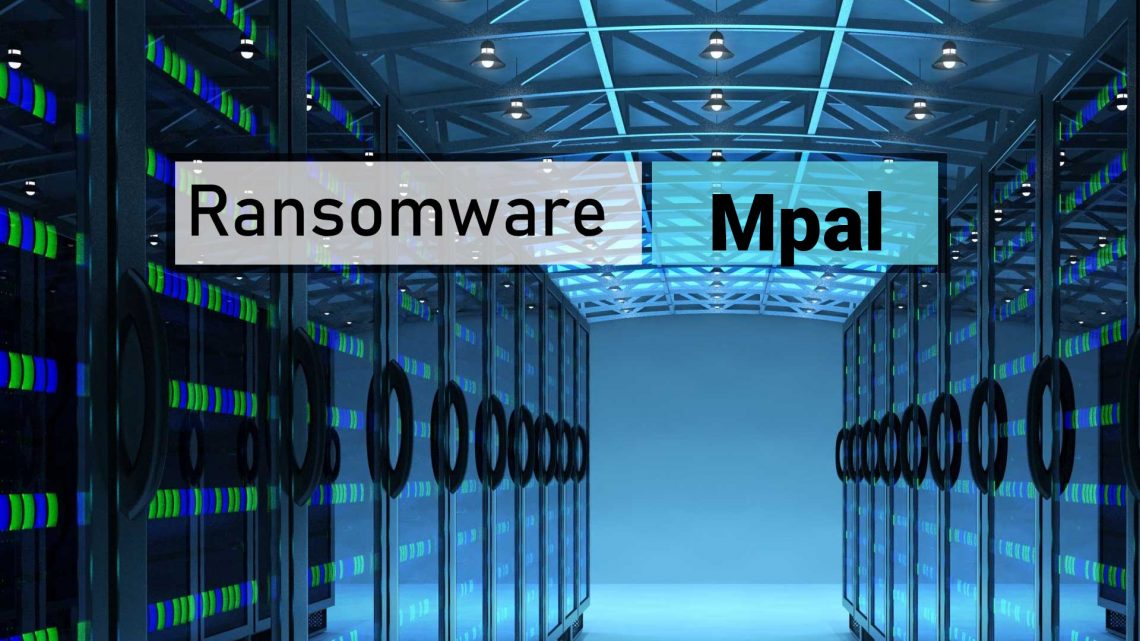

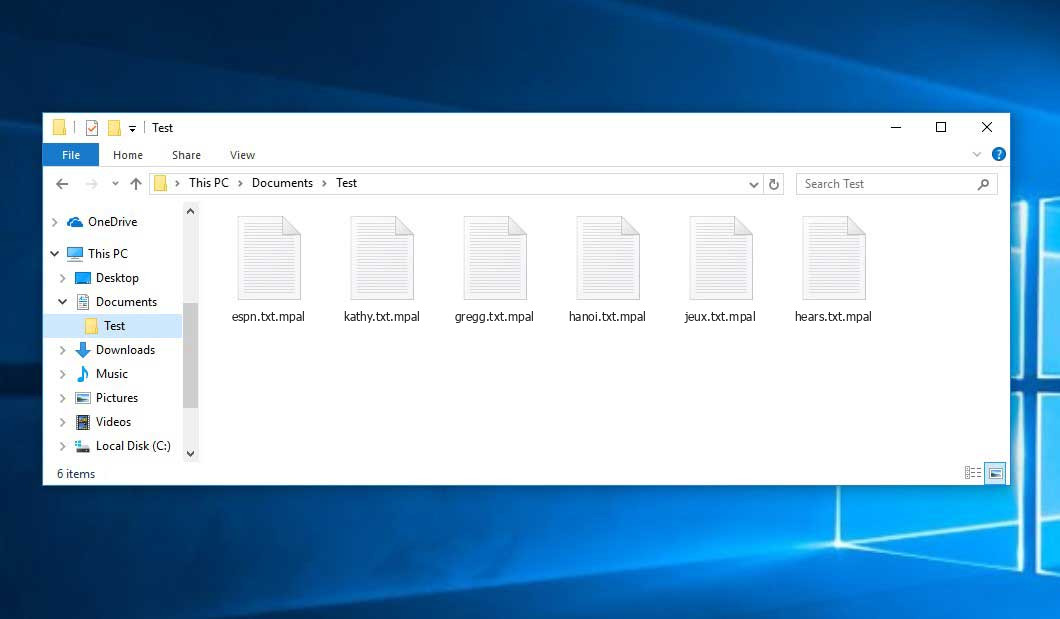
.mpal hacked my laptop.please help me to out from this
MY SYSTEM IS INFECTED WITH THE NEW VERSION OF mpal FILE.
I used the Decrypt software given the site but it wasnt able to decrypt my files.
requesting you please update the MPAL version and notify on the site.
would be really thankful for it!
I was inffected by .Mpal virus, unfortunely EMSISOFT STOP Decryptor doesn,’t work for .Mpal online key, Can you help please?
i have remove SQPC
Decryptor :
No key for New Varian online ID: 1faRVrGU0Ng7fk1atQeinZT2kNz7oSGFwHAVfBfF
Notice: this ID appears to be an online ID. decryption is impossible
.mpal hacked my computer.please help me to out from this
MY SYSTEM IS INFECTED WITH THE NEW VERSION OF mpal FILE.
I used the Decrypt software given the site but it wasnt able to decrypt my files.
requesting you please update the MPAL version and notify on the site.
would be really thankful for it!
Source: https://howtofix.guide/mpal-virus/
Hi,
Thanks for make this article,but I used the Decrypt software given the site but it wasnt able to decrypt my files.
My PersonalID.txt (2020/5/2) : Z61o28ZdQLWuSNi5zwW7U1EPimoLITjsiEG9NNJr
Please help me how to do.